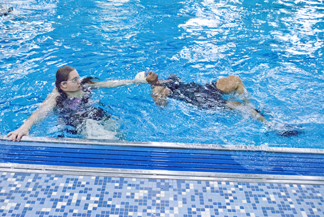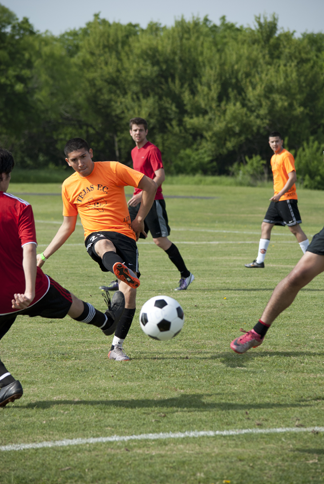By Karen Gavis/se news editor

Georgia Phillips/The Collegian
Imagine for a moment, instead of a well-manicured, grass-laden, weed-free landscape, that visitors on SE Campus could view dandelions swaying in the wind alongside uncut natural grasses, a virtual step back in time to a more primitive place where bluebonnets trumped St. Augustine and butterflies, birds and bees beckoned the call of native plants and dancing wildflowers.
This spring, SE’s native Texan roots will become observable as plans are under way to restore part of the terrain to what an open range cowboy or Texas pioneer may have enjoyed.
Assistant geology professor Chris Baack, biology instructor Regina Huse and landscaper Marc Villanueva are leading the Nature Wildflower and Prairie Restoration Project, whose goal is to restore native blackland prairie on SE.
Baack said if SE’s landscape could be returned to its native state, the campus would not need to worry about pesticides or irrigation.
“We are not extreme tree huggers,” she said.
Considering the historic drought that Texas experienced last summer, the project will help conserve water in Texas, Huse said.
“This way, you have things that are much hardier,” she said. “We can’t be irresponsible with water. We can’t.”
SE is currently under a twice-weekly watering restriction, and non-native plants do not thrive as well as native ones, Villanueva said. Plants that survive are “tough little suckers.”
“Almost every tree out here was stressed during the drought,” he said.
Randy Johnson, director of horticulture at the Texas Discovery Gardens in Dallas, said 80 percent of water usage in Dallas County goes directly into the landscape, and Texans need to reverse those types of percentages.
“We need to start growing and developing what works well here,” he said.
Johnson thinks it is ironic that people spend small fortunes to grow beautiful lawns just to mow them down.
The Discovery Garden’s Texas Native Plant Collection was watered only three times from the last rain in June until September last year, Johnson said. Historically, the plants that appeared in Texas were drought-tolerant.
“They had to be because they didn’t get much rain here,” he said.
Huse said the SE project has not been expensive and will ultimately save the college money.
Villanueva said beauty does not have to be sacrificed, and planting the right plants will save water as well as man-hours and fuel. Plus, there will be additional benefits such as seed harvests and a larger variety of flowers for pollination. However, Villanueva said he is uncertain how the public will respond to a more natural and untrimmed look.

David Reid/The Collegian
On SE’s south side, a maintenance shed harbors a makeshift greenhouse where Villanueva carefully cares for a variety of fragrant plants, herbs and flowers. Although they appear content where they are, the plants await new homes somewhere on campus. Dill, rosemary, basil and cilantro nestle together and grow proudly for SE’s culinary department while Villanueva envisions a garden just outside its culinary kitchen.
Raising the blinds in her third-floor office located in the ESCT wing, Huse looked out her window to absorb the sunlight and an open view of the landscape. Huse said SE is fortunate to have so much raw land that is undeveloped and uncompromised.
SE biology and geology students along with volunteers will plant the desired landscape from seed before the Texas temperature rises. They will also gather seeds that the plants produce for future plantings. The group has consulted with the Native American Seed Company and the Native Plant Society of Fort Worth for the project.
A blackland prairie mix of native Texas grasses and wildflowers such as buffalograss, black-eyed Susan and butterfly weed will be planted near campus entrances while a wetland mix of flowers like spiderwort, American basket flower and pink evening primrose will be planted near the pond.
“We can teach class out there,” Huse said. “It is not just for pretty.”
Bach said a lot of prep-work will not be required. However, non-native grasses will need to be removed because they compete. Currently, the grass at SE is not native to the area, but buffalograss is.
“It may be kind of clumpy, but that’s what was here,” Baack said. “This all used to be prairie.”

Georgia Phillips/The Collegian
Villanueva said Texans need to plant species that are less thirsty and right for the soil. Bluebonnets will be part of SE’s planned landscape agenda.
“We plant so much grass, here in Texas that is a weed,” he said.
SE president William Coppola said the plan is to return part of the campus to its original state prior to construction.
“The whole idea is to use plants that are natural to this part of Texas that should be watered with natural rainwater,” he said. “It is also a good educational tool for students to learn the natural plants of the area.”
Before coming to SE, Coppola said he helped start a satellite college that conserved water through natural landscape and bioswales, which are used to collect and recycle rainwater.
“I am so excited to come to a campus that is concentrated on conservation,” he said.
Coppola said he does not have a green thumb, and although he will be involved in the project, he plans to leave the planting to “those who know what they are doing.”
“The best thing they can do is keep me away from this,” he said.
Huse said different plants attract different animal species, and if natural landscape disappears, animals associated with those type plants lose their habitat.
“The vast majority of species going extinct today are flowering plants,” she said.
Currently, part of SE’s scenery contains a natural oasis, a small haven that attracts a myriad of creatures.
“In the spring, we get bunnies and then the hawks will come too,” Huse said. “There are fish like crazy out in that pond.”
In addition, Baack said duck and turtle families live in the pond, which served as a stock tank when cattle previously roamed the land.
“It’s been a long time since I’ve seen a rat,” she said.
Former SE student Ricky Pender said he saw a herd of deer gathered near the pond one winter.
Villanueva spotted a rabbit scurrying from beneath a hedge onto the campus lawn. He has also seen a coyote and a bobcat. Turtles crawl across the road from the pond to lay their eggs along the east side of the main building, Villanueva said. He will sometimes receive five calls a day about turtles in the road and will rescue them and return them to the pond.
“They are wanting to come over here now,” he said.
The Nature Wildflower and Prairie Restoration Project is supported by Tree Campus USA. SE was named a 2011 Tree Campus USA by the Arbor Day Foundation for meeting the required standards for sustainable campus forestry. The recognition honors the college’s commitment to effective forestry management within the community.
Huse and Baack were inspired to create the project after visiting the Lady Bird Johnson Wildflower Center in Austin, they said. They caught and now share the former first lady’s vision of restoring natural beauty through native landscape.
They hope SE will be an abode for more small animals and a place the community will visit and enjoy for years to come.
“You don’t have to water it. You don’t have to mow it,” Huse said. “And it will be prettier for the community.”

























